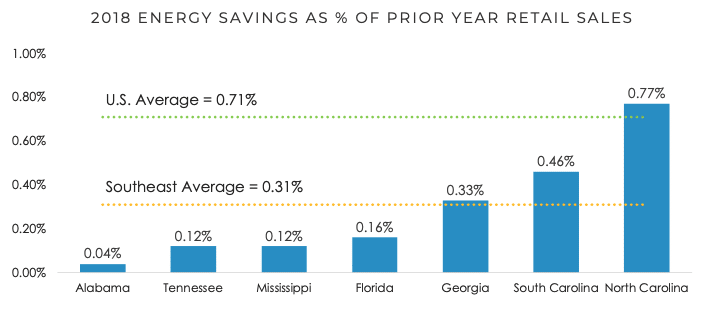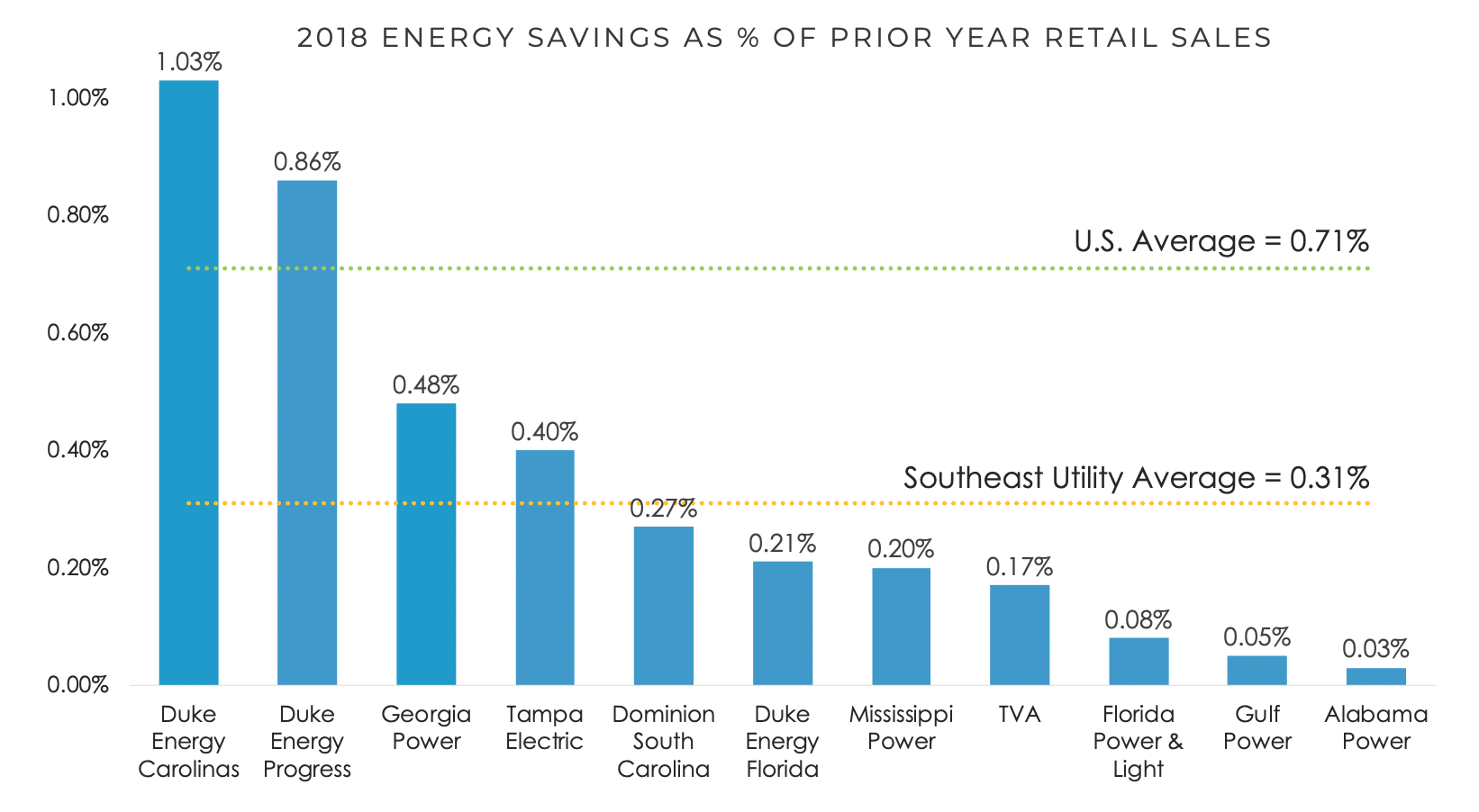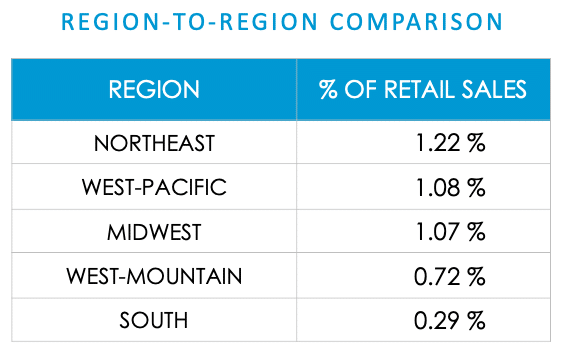Duke Energy and North Carolina continue to lead the Southeast on energy efficiency, accounting for vastly more energy savings than any other utility or state in the region. New state policies and corporate emissions reduction commitments set the stage for even more savings in coming years, despite headwinds.
Forest Bradley-Wright | February 19, 2020 | Energy Efficiency, North Carolina, UtilitiesNorth Carolina Leads the Southeast
SACE’s 2019 Energy Efficiency in the Southeast Annual Report shows that North Carolina continues to be the clear leader on energy efficiency in the Southeast. In fact, it was the only state in the region to exceed the national average for annual energy savings as a percentage of retail sales in 2018 (the most recent year for which data is available). Energy efficiency drives bill savings: North Carolina residential customers had the lowest average electric bills of all Southeast states analyzed.

With just 17% of the region’s total population, North Carolina accounted for 40% of all energy savings in the entire Southeast. Per capita efficiency savings in the state were more than three times higher than the rest of the region.
While North Carolina is clearly exceptional among peer utilities in the South, that is admittedly a pretty low bar. And although the state comes in above average by national standards, it can look to numerous higher achieving states in the Northeast, Midwest, and Pacific regions as it strives for further savings in the coming years.
Historic Policies Positioned North Carolina for Leadership
Many years of supportive state policies laid the foundation for North Carolina’s recent relative success. In particular, the state’s generous performance incentives gave its largest utility operator, Duke Energy, the ability to earn on its efficiency investments – even as customers spend less on their energy bills. Efficiency provisions in the state’s Renewable Energy Portfolio Standard have been another important driver, with Duke regularly exceeding the allotted annual savings threshold. Policies in South Carolina are also generally aligned, giving Duke Energy Carolinas (DEC) and Duke Energy Progress (DEP) the ability to deploy a broad set of roughly similar programs across both companies and both states. This, in turn, enables economies of scale and administrative efficiencies in program delivery.
New Driver for Efficiency: Carbon Emissions Reduction Commitments
Attractive economics is the primary driver for policies supporting energy efficiency advancement. It simply costs less to invest in effective energy efficiency programs than to supply power for wasted energy. Recently, however, changing political landscapes and corporate commitments have led to another potentially potent driver for expanding efficiency in the coming years: reducing carbon emissions. Energy efficiency cuts demand for fossil fuel power generation, offsets the need for construction of new power plants, and can assist in retiring outdated, polluting legacy power plants. Efficiency also facilitates the transition to renewable energy, lowering total investment costs by first reducing customer demand. North Carolina’s governor, Utility Commission, and Duke Energy have all recently indicated their intention to cut carbon pollution:
- In October 2018, Governor Roy Cooper issued Executive Order 80 with the aim to reduce greenhouse gas emissions in the state 40% by 2025.
- In August 2019, the North Carolina Utilities Commission ordered major changes in how Duke conducts integrated resource planning. The utility is now expected to rework how efficiency is modeled against potential new supply-side additions, is required to have existing coal power plants compete against clean energy alternatives, and must show how resource plans could achieve the governor’s carbon emissions targets.
- In September 2019, Duke Energy announced plans at the corporate level to cut emissions across all its companies 50% by 2030 and reach net zero carbon by 2050.
Replacing fossil fuel generation represents a major opportunity for energy efficiency, especially when combined with renewable energy and battery storage.
The Duke Effect
North Carolina’s successful efficiency gains in recent years can be attributed almost entirely to the state’s largest utility, Duke Energy. For the second consecutive year, Duke Energy Carolinas achieved efficiency savings in excess of 1% of prior year retail sales, again earning the top ranking spot among utilities in the region in SACE’s 2019 Energy Efficiency in the Southeast Annual Report. At 0.86%, Duke Energy Progress held the second-highest savings position by a considerable margin. In 2018, these two utilities delivered over $900 million of net present value savings to customers in the Carolinas.

No other Southeastern utility was even close to reaching the 0.71% national average for annual energy savings. Georgia Power and Tampa Electric exceeded the 0.31% regional average, but the remaining major utilities failed to deliver even that level of savings for their customers. Unfortunately, this includes Duke Energy Florida (DEF), which trailed far behind its sister companies in the Carolinas at just 0.21% efficiency savings.
Duke’s Corporate Culture Supports Efficiency
North Carolina’s policy leadership is reinforced by Duke Energy’s supportive corporate culture and a strong internal team responsible for designing and delivering a wide range of energy efficiency programs. Some members of Duke’s efficiency program staff work across all six Midwest and Southern states where the company operates. This breadth of experience facilitates the development of new program approaches, helps with identifying key lessons, and informs their approach when executing new strategies. Moreover, through Duke’s unique Energy Efficiency Collaborative, the company has also demonstrated a focus on continuous improvement and willingness to work with efficiency advocates and stakeholders that is unrivaled in the Southeast.
Facing the Headwinds
The road ahead includes some significant challenges for Duke despite recent accomplishments. The company is projecting substantial declines in future efficiency savings. For 2020, DEC projects a 20% reduction, DEP projects a 9% drop, and DEF’s meager 0.27% target will fall precipitously over the next five years. Duke explains their projections by pointing to lower avoided costs rates, better building codes, and higher efficiency standards for lighting and appliances, noting that each of these erodes the savings that can be attributed directly to utility efficiency programs.
Duke is not alone in facing these challenges. Other utilities across the country face similar pressures, but for years the most successful utilities have used innovation and effective program design to overcome similar changes and many have still steadily increased their efficiency savings. Through the Energy Efficiency Collaborative, Duke has support from numerous energy efficiency advocates to identify new programs and savings opportunities that could help the company again exceed 1% annual savings in future years.
Room for Improvement
Even with North Carolina and Duke Energy’s success to date, there is still considerable room for improvement. Leading energy efficiency states like Rhode Island and Massachusetts are delivering savings that are approximately four times higher.

Duke Energy Florida’s performance on energy efficiency stands in stark contrast with its sister companies in the Carolinas. The utility’s shortfall is largely a matter of policy: the Florida Commission penalizes efficiency by treating all energy savings as a cost to the utility, rather than counting it as a benefit to customers. Florida is also the only state to automatically eliminate any efficiency measure that pays back in 2 years or less. These ridiculous policies run directly counter to the reason we all do energy efficiency in the first place – to reduce customer bills by capturing the most cost-effective energy savings available. In effect, this incentivizes utilities to do less – rather than more – efficiency for customers.
The difference between Duke’s performance in Florida versus the Carolinas is a textbook case for why supportive policies are needed for energy efficiency.

Excluding Duke Energy’s efficiency savings, North Carolina’s annual efficiency savings in 2018 would have been a mere 0.22%. North Carolina’s co-operative and municipal utilities are still providing very little energy efficiency for their customers. There are still considerably more efficiency savings available in the state.
This blog is part of a continuing series following the release of the Energy Efficiency in the Southeast 2019 Annual Report.
- Read Part 1 of the series giving an overview of the report: “Energy Efficiency in the Southeast” 2019 Annual Report.
- Read Part 3 of this series looking at the relationship between energy efficiency and integrated resource planning in Mississippi: “Efficiency in Mississippi: Utilities Can Do More, Customers Deserve No Less.“
- Read Part 4 that examines how the largest utilities in the Southeast stack up with their national peers on energy efficiency.
- Watch a webinar where SACE technical staff discusses report findings.
- Additional blogs related to energy efficiency in the Southeast here.
Notes:
For purposes of data calculations referenced in this blog, the Southeast region for SACE does not include the portion of North Carolina in the PJM territory served by Dominion Energy.
SACE regularly participates in Duke’s Energy Efficiency Collaborative meetings and is a formal participant in official utility regulatory proceedings related to Duke Energy’s efficiency efforts in North Carolina, South Carolina, and Florida.
#EEinSE2019